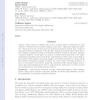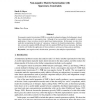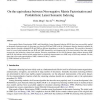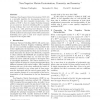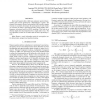ICA
2010
Springer
14 years 4 months ago
2010
Springer
Scanning process usually degrades digital documents due to the contents of the backside of the scanned manuscript. This is often because of the show-through effect, i.e. the backsi...
JMLR
2010
14 years 5 months ago
2010
Sparse coding—that is, modelling data vectors as sparse linear combinations of basis elements—is widely used in machine learning, neuroscience, signal processing, and statisti...
JMLR
2008
14 years 7 months ago
2008
We study a generative model in which hidden causes combine competitively to produce observations. Multiple active causes combine to determine the value of an observed variable thr...
CORR
2002
Springer
14 years 7 months ago
2002
Springer
Abstract. Non-negative sparse coding is a method for decomposing multivariate data into non-negative sparse components. In this paper we briefly describe the motivation behind this...
CORR
2004
Springer
14 years 7 months ago
2004
Springer
Non-negative matrix factorization (NMF) is a recently developed technique for finding parts-based, linear representations of non-negative data. Although it has successfully been a...
CSDA
2008
14 years 7 months ago
2008
Non-negative Matrix Factorization (NMF) and Probabilistic Latent Semantic Indexing (PLSI) have been successfully applied to document clustering recently. In this paper, we show th...
CORR
2008
Springer
14 years 7 months ago
2008
Springer
Traditional Non-Negative Matrix Factorization (NMF) [19] is a successful algorithm for decomposing datasets into basis function that have reasonable interpretation. One problem of...
CORR
2008
Springer
14 years 7 months ago
2008
Springer
The instances of templates in Wikipedia form an interesting data set of structured information. Here I focus on the cite journal template that is primarily used for citation to art...
ICASSP
2010
IEEE
14 years 7 months ago
2010
IEEE
This paper proposes a novel algorithm for minimizing the perceptual distortion in non-negative matrix factorization (NMF) based audio representation. We formulate the noise-to-mas...
ICASSP
2010
IEEE
14 years 7 months ago
2010
IEEE
Real world sounds often exhibit non-stationary spectral characteristics such as those produced by a harpsichord or a guitar. The classical Non-negative Matrix Factorization (NMF) ...

